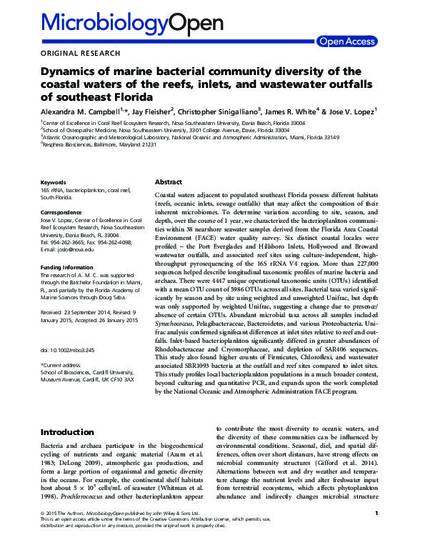
- 16S rRNA,
- Bacterioplankton,
- Coral reef,
- South Florida
Coastal waters adjacent to populated southeast Florida possess different habitats (reefs, oceanic inlets, sewage outfalls) that may affect the composition of their inherent microbiomes. To determine variation according to site, season, and depth, over the course of 1 year, we characterized the bacterioplankton communities within 38 nearshore seawater samples derived from the Florida Area Coastal Environment (FACE) water quality survey. Six distinct coastal locales were profiled – the Port Everglades and Hillsboro Inlets, Hollywood and Broward wastewater outfalls, and associated reef sites using culture-independent, high-throughput pyrosequencing of the 16S rRNA V4 region. More than 227,000 sequences helped describe longitudinal taxonomic profiles of marine bacteria and archaea. There were 4447 unique operational taxonomic units (OTUs) identified with a mean OTU count of 5986 OTUs across all sites. Bacterial taxa varied significantly by season and by site using weighted and unweighted Unifrac, but depth was only supported by weighted Unifrac, suggesting a change due to presence/absence of certain OTUs. Abundant microbial taxa across all samples included Synechococcus, Pelagibacteraceae, Bacteroidetes, and various Proteobacteria. Unifrac analysis confirmed significant differences at inlet sites relative to reef and outfalls. Inlet-based bacterioplankton significantly differed in greater abundances of Rhodobacteraceae and Cryomorphaceae, and depletion of SAR406 sequences. This study also found higher counts of Firmicutes, Chloroflexi, and wastewater associated SBR1093 bacteria at the outfall and reef sites compared to inlet sites. This study profiles local bacterioplankton populations in a much broader context, beyond culturing and quantitative PCR, and expands upon the work completed by the National Oceanic and Atmospheric Administration FACE program.
Supporting Information for this Article can be found here:
http://onlinelibrary.wiley.com/doi/10.1002/mbo3.245/suppinfo
Available at: http://works.bepress.com/jose-lopez/95/

©2015 The Authors. MicrobiologyOpen published by John Wiley & Sons Ltd. This is an open access article under the terms of the Creative Commons Attribution License, which permits use,distribution and reproduction in any medium, provided the original work is properly cited.